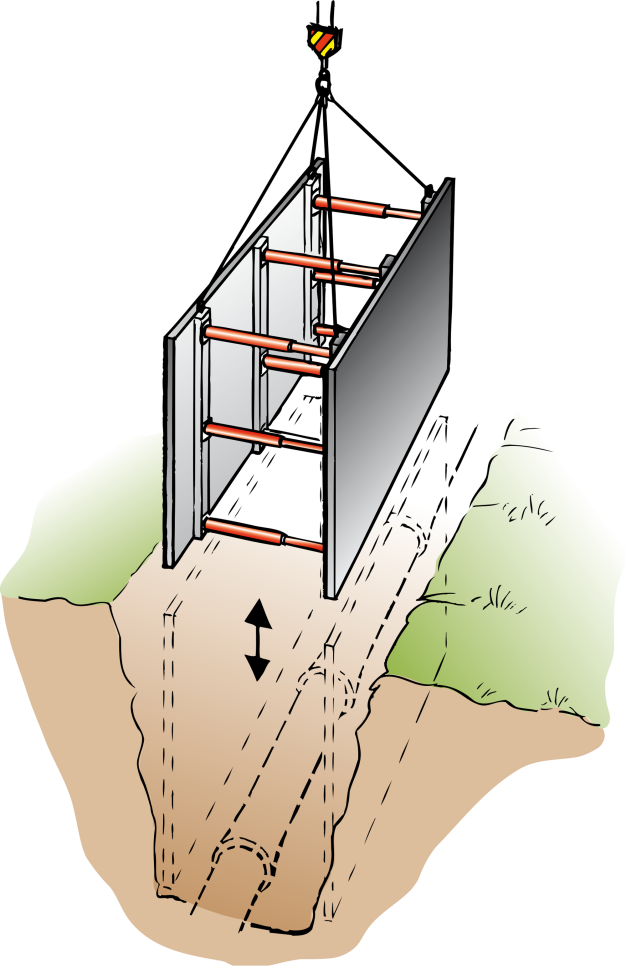Ground work and foundation work
Ground work should be planned so that the stability in the ground will be sufficient. The risk of collapses, landslips, bottom heaves or other unplanned changes in the ground should be prevented. One should also investigate if there are any materials or substances dangerous to the health, or installations, cables or other distribution systems, in the ground before the excavation starts. Foundation work includes many different works that aim to create a stable foundation to build on.
Prevent the risk of collapse
Supportive structures, for example tongues, should be used if there is a risk of collapse. Alternatively, the excavation may be carried out with a slope gradient.
If the excavations will be deep, or if the earth layer is loose, it is recommended that a geotechnician assess the risk of collapse and give suggestions of measures to prevent it.

The stability of a slope is governed by, for example, the height, the gradient and the earth layers resistant qualities and weight, but the subsoil water level and other factors also have an effect. Quick changes of weather, like a lot of rain or rapid temperature fluctuations, can change the condition of the ground, and can mean that one must carry out new assessments.
Shaking, vibrations and new loads on the ground can affect excavation work. These can come from roads or railways, passing work vehicles, nearby buildings, material stock or excavation masses. Therefore, it is important that vehicular traffic does not drive too close to the excavation and that the excavation masses are not placed too close to the edge.
When the groundwork entails tipping of material or passing vehicular traffic beside where the work is ongoing, it is important that there are barriers preventing vehicles from driving or falling down into the excavation. A rule of thumb for appropriate height for a stop device during tipping is a height corresponding to half the wheel diameter of the vehicle.
Investigate what is in the ground before excavation is started
Before any excavation starts it is required to investigate if there are any materials or substances dangerous to the health, or installations, cables or other distribution systems, in the ground. If any of that is present in the ground, measures against the risks for health and safety must be taken.
The risk of digging off installation cables for electricity, water and drainage or gas must be prevented. Employees who work with water pipes, drainage pipes or contaminated earth can need vaccinations against certain communicable illnesses and can also need personal protective equipment.
Work must be conducted under the direction of a competent person
Excavation work must be started and carried on under the direction of a competent person if supportive structures need to be used, or if the excavation must be carried out with a slope gradient. The same applies if there are materials or substances dangerous to the health, or installations or cables, present in the ground.
Other work environment risks during excavation
Another serious risk for accidents during excavation work is if there are persons around the machine or in the pit. The driver of the machine can by mistake back over or hit a person with the bucket. There is also a risk for the bucket to come loose. That is the reason why it is best to block persons which the operator might not see, from coming into the risk area.
Other work environment risks in connection with excavation can be quartz dust, musculoskeletal risks with heavy lifting of equipment as well as vibrations for those who work in and with machinery.
In areas with excavation work, one can need to water or combat dust with other methods. Machines that carry out excavation and earth moving need to be equipped with an air conditioning system and cabin filter that are adapted for the risks with quartz, in order to provide a good driver environment.
Foundation work
Foundation work includes many different works that aim to create a stable foundation to build on.
It can be piling, ground reinforcement, tongue and other support structures. These works implies large machines and lifting of heavy prefabricated elements, for example iron tongues or concrete piles that are hit down into th ground. Alternatively, chemicals are injected into the ground under high pressure. The work sets high demands on planning of the work area in order to
- Stability for heavy mvhines to be able to work
- Safety during lifting
- Risks with chemicals under high pressure, like lime, that can leak
Here you can read more about chemical and biological substances
Last updated 2024-01-04
